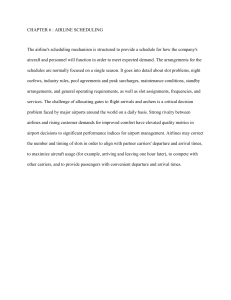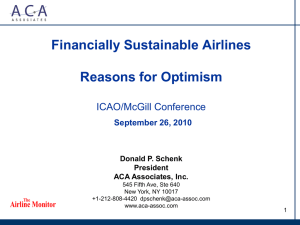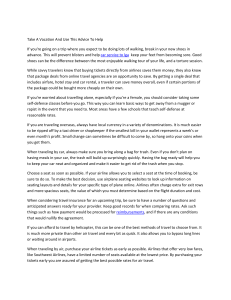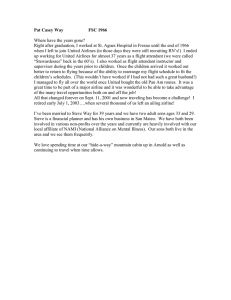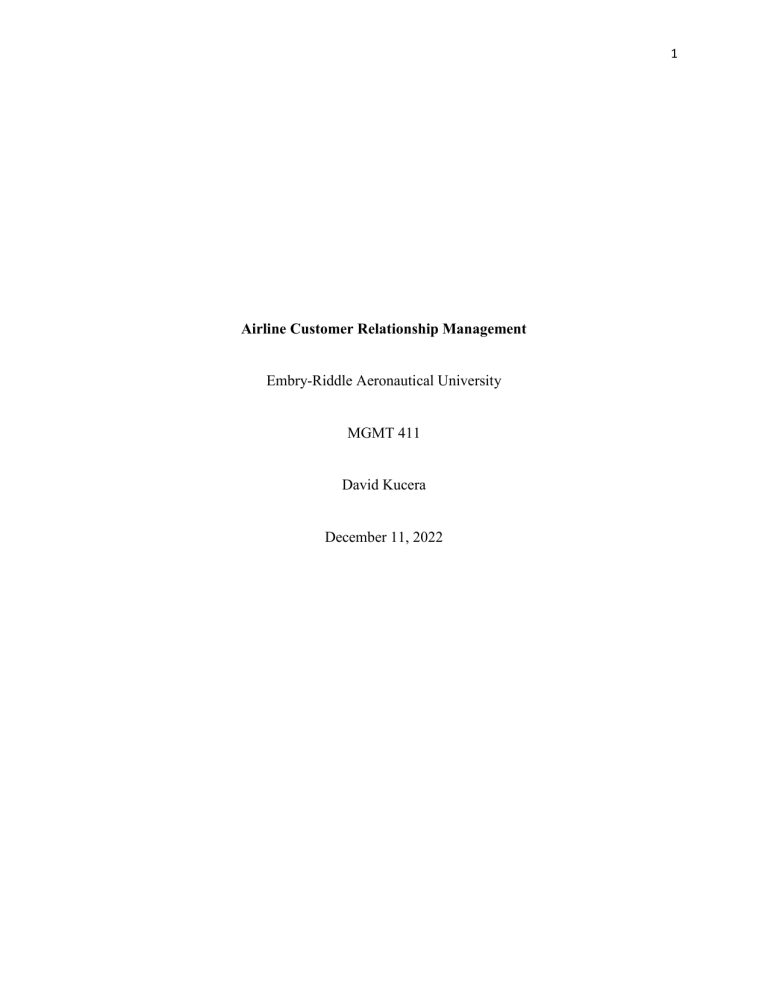
1 Airline Customer Relationship Management Embry-Riddle Aeronautical University MGMT 411 David Kucera December 11, 2022 2 Abstract How do airlines use Customer Relationship Management (CRM) to build customer loyalty and satisfaction? Airlines have been using CRM to make their customers loyal and to build a good relationship with them. It is a strategy to determine customers’ needs and wants such as ticket pricing, flight destinations and times, entertainment and much more. Good customer service is one of the most important reasons for customer loyalty and satisfaction. Airline industry is a highly competitive market as customers have many different airlines to choose from and find the one that best suits them. Airlines use CRM by providing quality service to customers through in flight-entertainment, benefits for members, airport lounges and by building a solid reputation which attracts new customers that later become loyal to the airline. 3 Today, millions of people travel by air every single day. Customers nowadays have big expectations from airlines as the competition is very high and there are a lot of options for their flights. There are many airlines to choose from which means it is in the airline’s best interest to provide the highest quality service they can. If the airline does not satisfy their customers, they will easily consider using another airline in the future. Customers also have a large choice of airports, so it is important that every hub the airlines operates from offers the same quality service for their customers. As Poskuviene, Ciziuniene and Matijosius (2022) describe, service quality emphasizes that customers must be listened to and that they are the best judges. Airlines must listen to their customer’s needs and wants. When an airline establishes a smooth highquality relation with their customers, it ensures the customer’s confidence, it is a pleasure to work together, and they all benefit from getting a service that the customer needs which results in a circle of regular customers (Poskuviene & Ciziuniene & Matijosius, 2022). After all, everybody likes to return to the same places and people when they had a good experience and felt a good connection. Even when airline has a hiccup of not arriving on time or when a food is not as tasty as on previous flights, having a good experiences and connection really helps as the customers will forgive the airline. Additionally, customers are often reluctant to change their service providers (Poskuviene et al., 2022). Customer relationship management (CRM) is important factor in airline’s success as the aviation industry is a highly competitive market. Airlines need to satisfy their customer as customer satisfaction has become one of the most important issues in marketing as it plays a crucial role in sustaining customers and maximizing profit (Khan, 2013). It costs airline less money to keep a customer than to find a new one. According to Hassan (2015), to acquire a new customer, it takes the sells department about 8 to 10 calls, however, to sell something to an 4 existing customer, it is only 2 to 3 calls. Additionally, Hassan also states that it is 5 to 10 times more expensive to acquire new customer than receive business from already existing customer (Hassan, 2015). As Salah and Abou-Shouk (2019) state, customer relationship can be defined as the implementation of relationship marketing principles through managing customer data and use of technology (Salah & Abou-Shouk (2019). The aim is to build long term customer loyalty through excellent customer service. By providing excellent customer service, the airline builds a strong relationship and ensures the customer will book more flights with the same airline in the future and the customer also develops a trust in the airline. Trust is important factor in building a relationship with customer. Creating trust in customer mind set its commitment. Customers will build a trust with and airline, for example, in an instance where they get arrive their destination on time consistently. On-time percentage is the most important statistic for showing how well an airline performs (Wallet, 2022). In 2022, Hawaiian airlines had the highest on-time percentage from all United States airlines which builds a great image for Hawaiian airlines and creates new customer opportunities as well as supporting customer loyalty. Another way how airlines build customer loyalty is by reacting to a crisis such as flight cancellations or delays. Crisis situations are common in the airline industry as the weather will sometimes be extreme and not allow for the airline to fly, or maintenance issues will arise, and they do not have another plane to substitute. There is also no way the airline can deal with nature factors; some flights need to be cancelled for safety reasons. Successful airlines will have a crisis management on what to do and say before the crisis even occurs. In today’s world of social media, airlines such as Delta uses their entire social media presence to communicate with passengers and answering their questions and queries. They also like to update their website regularly which provides much-needed flight information for their customers (Atherton, 2021). 5 Most important is to be honest with the customers as it again builds trust. Communication technology has also transferred the airline worlds in a sense that they now require less of a communication between them and their customers than before. Customers are now able to check in using a self-service counter which benefits the customers as they do not need to wait in lines for check-in and it speeds up the process, thus enhancing the customer’s experience. A study made by Chen and Wang (2016) focused on how customers using online check-in systems or kiosks creates customer satisfaction and has a positive effect on customer loyalty. As they describe in their paper, satisfaction refers to the perceived discrepancy between prior expectation and perceived performance after consumption (Chen & Wang, 2016). Before, customers were used to waiting in lines for sometimes an hour to get their language weighed, checked-in and receive their flight ticket with gate and seat information which made their overall flying experience not enjoyable. This all happened even before the airline could offer them any of their services on the plane or at the airport that would enhance their experience. Nowadays, customers can use the check-in systems which only takes minutes. Chen and Wang (2016) used their conceptual model seen on and used method of collecting their data from customers at two major airports in Taiwan (see Fig. 1) (Chen & Wang, 2016). They stated that customers perceive three different values: enjoyment value, economic value, and relational value. All these three values can be seen in using check-in systems at the airports and result in building customer loyalty with airlines. There are many other reasons for airlines to use a good customer relationship management where they collect and store customers data. One reason is to discover what caused a customer to have a good or bad experience. Customers help the airlines a lot with this as they 6 will often write reviews when they had a good or bad experience. Airlines will use this data to learn from their mistakes or to keep doing things the same way, if not better. Fig. 1. The Conceptual model A study conducted by Lucini, Tonetto, Fogliatoo and Anzanello (2020) measured airline’s customer satisfaction using text mining methods such as online customer reviews. The study analyzed about 55,000 customer reviews which covered over 400 airlines from 170 countries (Lucini & Tonetto & Fogliatoo & Anzanello, 2020). The study divided customer satisfactions into different dimension such as reviews for good or bad customer service, flight description, food and drinks or onboard service and entertainments. The most reviews positive or negative were focused on customer service (see Fig 2.) This proves that customer service is the most important factor for airline’s reputation and overall success. Airlines have been using CRM to make their customers loyal and have a good relationship with them. It is a strategy to determine customers’ needs and wants such as ticket 7 pricing, flight destinations and times, entertainment and much more. Good customer service is one of the most important reasons for customer loyalty and satisfaction. Airline’s customer’s satisfaction begins with the way of ordering a ticket. Thanks to the world’s digitalization, nowadays airlines use their own e-ticketing portals where travelers can order their tickets, see the pricing, and choose their seat, possibly upgrade, pay for their luggage, store the tickets in their phone wallets and upon checking in, they show their identification and scan a QR code. This makes the experience for the passenger easier than ever before and the airline benefits from this as they reduce their booking expense and eliminate the need for printing and mailing paper documents (Tech Target, n.d.). Fig. 2. Satisfaction dimensions and distribution 8 Airlines have been using CRM to make their customers loyal and have a good relationship with them. It is a strategy to determine customers’ needs and wants such as ticket pricing, flight destinations and times, entertainment and much more. Good customer service is one of the most important reasons for customer loyalty and satisfaction. Airline’s customer’s satisfaction begins with the way of ordering a ticket. Thanks to the world’s digitalization, nowadays airlines use their own e-ticketing portals where travelers can order their tickets, see the pricing, and choose their seat, possibly upgrade, pay for their luggage, store the tickets in their phone wallets and upon checking in, they show their identification and scan a QR code. This makes the experience for the passenger easier than ever before and the airline benefits from this as they reduce their booking expense and eliminate the need for printing and mailing paper documents (Tech Target, n.d.). Using the data from CRM, airlines divide their passengers into groups based on their demographics. As the markets evolve, so do the customers who have different expectations from the airlines (Blaga, 2019). Loyal customers tend to book airline tickets more frequently and these people are attractive for the airline because they typically are not choosing an airline based on price, but rather their positive experience with the airline and loyalty. Airlines no longer only focus and divide their passengers on whether they travel for business or pleasure. Behavioral segmentation helps the airlines to understand which passenger is willing to pay for business or first-class ticket. These customers tend to book their tickets very close to the departure date which gives the airline the opportunity to underly the price sensitivity for certain routes or periods (Blaga, 2019). Many Airlines offer different privileges and perks to their loyal customers when they join their club or obtain their membership. They reward these people with discounted tickets or upgrade, priority checking and boarding, free Wi-Fi, food and drinks, hotels, car rental, 9 points redemption for future flight tickets and much more. Qatar Airways offer different types of tiers; silver, gold and platinum. The higher membership, the more benefits the customers can enjoy (Qatar, n.d.). Large airlines also build customer loyalty by providing an airline lounge where passengers can enter via their memberships or a fee. These lounges provide all-you-can eat food, showers, internet or even a pool and much more, depending on the airport’s size. Airline lounge is a highly experiential service setting and provides passengers with a place to relax and refresh before or after their flight (Kim & Chua & Lee & Boo & Han, 2015). Traditionally, it is known that airline’s food is not very good mainly because the cabin altitude air is 15% drier which makes the passengers more dehydrated and dry-mouthed (Gupta, 2022). As Han, Moon, ArizaMontes and Lee (2020) describe, in-flight meals is one of key tangible services that are considered to be a crucial part of airline’s service quality (Han & Moon & Ariza-Montes & Lee (2020). If an airline can have good food in every passenger class; first, business, premium economy and economy, the customers will remember it and the word will typically spread the word among others. For example, Korean Air serves traditional Korean foods on their airline which in return boosts international customer’s pleasure and is one of the crucial means of differentiating themselves (Han et al., 2020). Airlines have also been providing their customers with in-flight entertainment which is another way to build customer satisfaction and loyalty. Nowadays, passengers can watch movies, shows, listen to music or play games with other passengers using a small screen in front of them. In-flight entertainment is an airline-provided service that ensures that passengers on long haul flights are comfortable and not bored (Jin & Kim, 2022). 10 To have a successful airline, one must analyze their customers behaviors. When passengers book a ticket, they look at the price, how many stops they would have to do to arrive at their destination, which inflight service the airline offers and their seat preference. However, it all starts with research. Airlines must have the best suitable flight dates and destinations accordingly to the demand of their passengers. To achieve this, it can take years and at first it can be a risk for the airlines as in the beginning they might not make profit on that flight at all. Building a solid brand with satisfied customers will reflect on the popularity of such airline and in return, bring new customers. Feedback about an airline that a customer wants to purchase a ticket as is very important for their purchase decision (Vohra, 2016). Sure, some people will not really look at reviews and all they care is to get from one point to another while spending as less as they can, but then they also do not expect to have a quality service. Lastly, building a good foundation for customer satisfaction will eventually bring customer loyalty. If a customer is satisfied with the service provided, it will reflect on positive reviews, returning customers and recommencing the product or service to others (Lucini, et al., 2020). Customer loyalty will bring sustainable revenue growth, marketing cost saving, favorable word of mouth referrals and increase overall airline profit (Han, et al., 2020). To answer the research question, airlines use CRM in a form of customer satisfaction to build customer loyalty. Satisfied customer will become loyal customer. 11 References Blaga, L., Airlines Customer Segmentation in the Hyper-Competition Era. (2019). Expert Journal of Marketing, 7(2), 137–143. Chen, C.-F., & Wang, J.-P. (2016). Customer participation, value co-creation and customer loyalty – A case of airline online check-in system. Computers in Human Behavior, 62, 346–352. https://doi.org/10.1016/j.chb.2016.04.010 Gupta, H. (2022, July 8). Why Does Food Taste Bad On Airplanes? Fun and interesting facts from science and the universe. https://www.scienceabc.com/eyeopeners/why-does-food-taste-bad-onairplanes Jin, M.-J., & Kim, J. K. (2022). Customer adoption factors for in-flight entertainment and connectivity. Research in Transportation Business & Management, 43, 100759–. https://doi.org/10.1016/j.rtbm.2021.100759 Han, H., Moon, H., Ariza-Montes, A., & Lee, S. (2020). Sensory/Health-Related and Convenience/Process Quality of Airline Meals and Traveler Loyalty. Sustainability, 12(3), 857–. https://doi.org/10.3390/su12030857 Khan, S. (2013). Attaining customer satisfaction! The role of customer value and relation base marketing a study of policy holders of Peshawar Pakistan. International Journal of Managing Value and Supply Chains, 4(1), 11-24 Kim, H.-C., Chua, B.-L., Lee, S., Boo, H.-C., & Han, H. (2016). Understanding Airline Travelers’ Perceptions of Well-Being: The Role of Cognition, Emotion, and Sensory Experiences in Airline Lounges. Journal of Travel & Tourism Marketing, 33(9), 1213–1234. https://doi.org/10.1080/10548408.2015.1094003 12 Lucini, F. R., Tonetto, L. M., Fogliatto, F. S., & Anzanello, M. J. (2020). Text mining approach to explore dimensions of airline customer satisfaction using online customer reviews. Journal of Air Transport Management, 83, 101760–. https://doi.org/10.1016/j.jairtraman.2019.101760 Poškuvienė, L., Čižiūnienė, K., & Matijošius, J. (2022). Analysis of Customer Service Quality Models and for their Approbation Opportunities in Aviation. Periodica Polytechnica. Transportation Engineering, 50(3), 285–292. https://doi.org/10.3311/PPtr.15213 Salah, M., Abouk-Shouk, A. (2019). The effect of customer relationship management practices on airline customer loyalty. Journal of Tourism, 5(2), 11– 19. https://doi.org/10.5281/zenodo.3601669 Tech Target. (2005, September 21). What is E-tickEt (electronic ticket)? WhatIs.com. https://www.techtarget.com/whatis/definition/e-ticket-electronic-ticket Qatar Airways. (n.d.). Privilege Club tiers. https://www.qatarairways.com/en-us/PrivilegeClub/membership-tiers.html?iid=ALL929 Vohra, A. (2016, November 3). Consumer behavior - Choosing airline for domestic travel. LinkedIn. https://www.linkedin.com/pulse/consumer-behavior-choosing-airline-domestic-travelaakriti-vohra Wallet, N. (2022, December 1). The list ranking the most on-time, reliable airlines, according to federal data. oregonlive. https://www.oregonlive.com/business/2022/12/the-most-on-time-reliableairlines-according-to-federal-data.html 13 Figures Figure 1 The Conceptual model September, 2016, from Journal of Air Transport Management. Copyright (2016) by Chen & Wang. 14 Figure 2 Satisfaction dimensions and distribution March, 2020, from Computers in Human Behavior. Copyright (2020) by Lucini & Tonetto & Fogliatto & Anzaanello.
